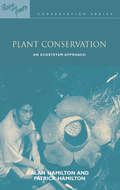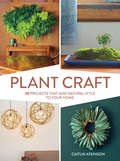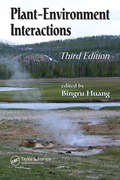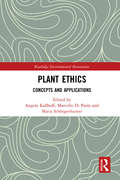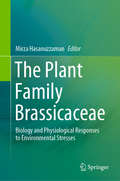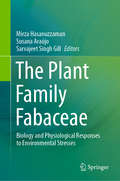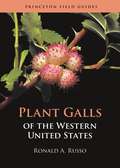- Table View
- List View
Plant Cell Culture
by Julian Coleman David Evans Anne KearnsPlant cell culture is an essential methodology in plant sciences, with numerous variant techniques depending on the cell type and organism. Plant Cell Culture provides the reader with a concise overview of these techniques, including basic plant biology for cell culture, basic sterile technique and media preparation, specific techniques for various plant cell and tissue types including applications, tissue culture in agriculture, horticulture and forestry and culture for genetic engineering and biotechnology. This book will be an essential addition to any plant science laboratory's bookshelf.
Plant Cell Walls
by Nicholas C. Carpita Malcolm Campbell Mary TierneyThis work is a comprehensive collection of articles that cover aspects of cell wall research in the genomic era. Some 2500 genes are involved in some way in wall biogenesis and turnover, from generation of substrates, to polysaccharide and lignin synthesis, assembly, and rearrangement in the wall. Although a great number of genes and gene families remain to be characterized, this issue provides a census of the genes that have been discovered so far. The articles comprising this issue not only illustrate the enormous progress made in identifying the wealth of wall-related genes but they also show the future directions and how far we have to go. As cell walls are an enormously important source of raw material, we anticipate that cell-wall-related genes are of significant economic importance. Examples include the modification of pectin-cross-linking or cell-cell adhesion to increase shelf life of fruits and vegetables, the enhancement of dietary fiber contents of cereals, the improvement of yield and quality of fibers, and the relative allocation of carbon to wall biomass for use as biofuels. The book is intended for academic and professional scientists working in the area of plant biology as well as material chemists and engineers, and food scientists who define new ways to use cell walls.
Plant Cold Hardiness: Gene Regulation and Genetic Engineering
by Paul H. Li E. Tapio Palvath We compiled this volume mostly from presentations at the 6 International Plant Cold Hardiness Seminar (PCHS) after consulting with Professor Tony H. H. Chen, Oregon State University, USA, Professor Pekka Heino, University of Helsinki, Finland, th and Dr. Gareth J. Warren, University of London, Surrey, UK. The 6 International PCHS was held at the Unitas Congress Center, Helsinki, Finland from July 1-5, 2001. There were 110 registered scientists at the serttinar representing 20 countries: Australia, Belgium, Canada, Chile, the Czech Republic, Denmark, Estonia, Finland, Gennany, Hungary, Iceland, Italy, Japan, Norway, Poland, Spain, Sweden, Taiwan, United Kingdom, and United States of America. The infonnation compiled represents the state of the art of research in phmt cold hardiness in tenns of gene regulation, gene expression, signal transduction, the physiology of cold hardiness and, ultimately, the genetic engineering for cold tolerant plants. The International PCHS was initiated in 1977 at the University of Minnesota, St. Paul, Minnesota. It has been traditionally held at 5-year intervals at various locations. th Because of the rapid advances of research in plant cold hardiness, attendees at the 6 meeting unanimously adopted a resolution to hold the seminar in 3-year intervals instead of 5 in the future. Consequently, the next seminar will be held in 2004 in Sapporo, Japan, and Professor Seizo Fujikawa from Hokkaido University will serve as the host.
Plant Collectors in Angola: Botany, Exploration, and History in South-Tropical Africa (Regnum Vegetabile)
by Estrela Figueiredo Gideon F. SmithAn authoritative treatise on the history of botanical studies and exploration in Angola. For any region, cataloging, interpreting, and understanding the history of botanical exploration and plant collecting, and the preserved specimens that were amassed as a result, are critically important for research and conservation. In this book, published in cooperation with the International Association for Plant Taxonomy, Estrela Figueiredo and Gideon F. Smith, both botanists with expertise in the taxonomy of African plants, provide the first comprehensive, contextualized account of plant collecting in Angola, a large country in south-tropical Africa. An essential book for anyone concerned with the biodiversity and history of Africa, this authoritative work offers insights into the lives, times, and endeavors of 358 collectors. In addition, the authors present analyses of the records that accompanied the collectors’ preserved specimens. Illustrated in color throughout, the book fills a large gap in the current knowledge of the botanical and exploration history of Africa.
Plant Collectors in Angola: Botany, Exploration, and History in South-Tropical Africa (Regnum Vegetabile)
by Estrela Figueiredo Gideon F. SmithAn authoritative treatise on the history of botanical studies and exploration in Angola. For any region, cataloging, interpreting, and understanding the history of botanical exploration and plant collecting, and the preserved specimens that were amassed as a result, are critically important for research and conservation. In this book, published in cooperation with the International Association for Plant Taxonomy, Estrela Figueiredo and Gideon F. Smith, both botanists with expertise in the taxonomy of African plants, provide the first comprehensive, contextualized account of plant collecting in Angola, a large country in south-tropical Africa. An essential book for anyone concerned with the biodiversity and history of Africa, this authoritative work offers insights into the lives, times, and endeavors of 358 collectors. In addition, the authors present analyses of the records that accompanied the collectors’ preserved specimens. Illustrated in color throughout, the book fills a large gap in the current knowledge of the botanical and exploration history of Africa.
Plant Conservation: An Ecosystem Approach
by Alan HamiltonIn this, the latest in the People and Plants series, plant conservation is described in the context of livelihoods and development, and ways of balancing the conservation of plant diversity with the use of plants and the environment for human benefit are discussed. A central contention in this book is that local people must be involved if conservation is to be successful. Also examined are ways of prioritizing plants and places for conservation initiatives, approaches to in situ and ex situ conservation, and how to approach problems of unsustainable harvesting of wild plants. Roles for botanists, foresters, sociologists, development workers and others are discussed. This book acts as a unifying text for the series, integrating case studies and methodologies considered in previous volumes and pointing out in a comprehensive, accessible volume the valuable lessons to be learned.
Plant Conservation: An Ecosystem Approach (People And Plants International Conservation Ser.)
by Alan HamiltonIn this, the latest in the People and Plants series, plant conservation is described in the context of livelihoods and development, and ways of balancing the conservation of plant diversity with the use of plants and the environment for human benefit are discussed. A central contention in this book is that local people must be involved if conservation is to be successful. Also examined are ways of prioritizing plants and places for conservation initiatives, approaches to in situ and ex situ conservation, and how to approach problems of unsustainable harvesting of wild plants. Roles for botanists, foresters, sociologists, development workers and others are discussed. This book acts as a unifying text for the series, integrating case studies and methodologies considered in previous volumes and pointing out in a comprehensive, accessible volume the valuable lessons to be learned.
Plant Craft: 30 Projects that Add Natural Style to Your Home
by Caitlin AtkinsonPlant Craft features 30 step-by-step projects inspired by the natural world and made out of live plants, cut flowers, foraged branches, and more.
Plant Defence: Biological Control (Progress in Biological Control #22)
by Jean-Michel Mérillon Kishan Gopal RamawatInsects, pests and weeds are responsible for substantial loss of crops and reduced food supplies, poorer quality of agricultural products, economic hardship for growers and processor. Generally, chemical control methods are neither always economical nor are they effective and may have associated unwanted health, safety and environmental risks. Biological control involves use of beneficial biological agents to control pests and offers an environmental friendly approach to the effective management of plant diseases and weeds. The chapters are written by well recognized group leaders in the field. This book provides a comprehensive account of interaction of host and pests, and development of biological control agents for practical applications in crops management utilizing inherent defence mechanism, induced stimulation and biological control agents. The contents are divided into the following sections: General biology of plant defence, Use of natural compounds for biological control, Use of biological agents, Mechanism of action and Commercial aspects. The book will be useful for academicians, researcher and industries involved in study and manufacturing these products.
Plant Disease (Collins New Naturalist Library #85)
by David Ingram Noel RobertsonPlant Disease covers all aspects of diseases of plants growing in the wild or likely to be encountered on cultivated plants in farm, forest and garden. This edition is exclusive to newnaturalists.com
Plant Diversity and Ecology in the Chihuahuan Desert: Emphasis on the Cuatro Ciénegas Basin (Cuatro Ciénegas Basin: An Endangered Hyperdiverse Oasis)
by Maria C. Mandujano Irene Pisanty Luis E. EguiarteEnvironmental and specific diversity in the Chihuahuan desert in general, and in the Cuatro Ciénegas Basin in particular, has long been recognized as outstanding. This book provides a global ecological overview, together with in-depth studies of specific processes. The Chihuahuan desert is the warmest in North America, and has a complex geologic, climatic and biogeographical history, which affects today’s distribution of vegetation and plants and generates complex phylogeographic patterns. The high number of endemic species reflects this complex set of traits. The modern distribution of environments, including aquatic and subaquatic systems, riparian environments, gypsum dunes and gypsum-rich soils, low levels of phosphorous and organic matter, and high salinity combined with an extreme climate call for a range of adaptations. Plants are distributed in a patchy pattern based on punctual variations, and many of them respond to different resources and conditions with considerable morphological plasticity. In terms of physiological, morphological and ecological variability, cacti were identified as the most important group in specific environments like bajadas, characterized by high diversity values, while gypsophytes and gypsovagues of different phylogenies, including species with restricted distribution and endemics.
Plant Ecology
by Ernst-Detlef Schulze Erwin Beck Klaus Müller-HohensteinThis textbook covers Plant Ecology from the molecular to the global level. It covers the following areas in unprecedented breadth and depth: - Molecular ecophysiology (stress physiology: light, temperature, oxygen deficiency, drought, salt, heavy metals, xenobiotica and biotic stress factors)- Autecology (whole plant ecology: thermal balance, water, nutrient, carbon relations)- Ecosystem ecology (plants as part of ecosystems, element cycles, biodiversity)- Synecology (development of vegetation in time and space, interactions between vegetation and the abiotic and biotic environment)- Global aspects of plant ecology (global change, global biogeochemical cycles, land use, international conventions, socio-economic interactions) The book is carefully structured and well written: complex issues are elegantly presented and easily understandable. It contains more than 500 photographs and drawings, mostly in colour, illustrating the fascinating subject.The book is primarily aimed at graduate students of biology but will also be of interest to post-graduate students and researchers in botany, geosciences and landscape ecology. Further, it provides a sound basis for those dealing with agriculture, forestry, land use, and landscape management.
Plant Ecology and Conservation
by Andrew LackPlant Ecology & Conservation is an introduction to the world of plant ecology. It includes the main areas of current research including ideas about plant populations, nutrition and plant community ecology and has a particular emphasis on the interactions of plants with animals, fungi and microorganisms whose important is being increasingly demonstrated. With the world’s environmental problems having such a high profile, the book focusses on the human impact on the world’s plant species. Conservation of the terrestrial world starts with plants as they form the basis of all ecosystems on land. We can only understand how best to conserve the world’s biodiversity with an understanding of the central role of plant ecology. This theme runs throughout with numerous examples of the disruption of ecosystems by human activity emphasising the connection between plant ecology and conservation. Key Features: Boxes present case studies, important statistics and interesting asides Full-colour photos depict key species and habitats and superb line drawings illustrate many concepts Important data are presented in Tables and Figures throughout Each chapter has Key Concepts and review questions to test a reader’s grasp of the content Key References and Further Reading are given for each chapter to point the reader towards the most important and influential literature Jargon is kept to a minimum and a full Glossary of all technical terms is presented The book is aimed primarily at undergraduate and graduate students in any aspect of ecology or plant science. It should also appeal to anyone interested in how plants function and are concerned about what is needed for the conservation of the world’s ecosystems.
Plant Ecology and Conservation
by Andrew LackPlant Ecology & Conservation is an introduction to the world of plant ecology. It includes the main areas of current research including ideas about plant populations, nutrition and plant community ecology and has a particular emphasis on the interactions of plants with animals, fungi and microorganisms whose important is being increasingly demonstrated. With the world’s environmental problems having such a high profile, the book focusses on the human impact on the world’s plant species. Conservation of the terrestrial world starts with plants as they form the basis of all ecosystems on land. We can only understand how best to conserve the world’s biodiversity with an understanding of the central role of plant ecology. This theme runs throughout with numerous examples of the disruption of ecosystems by human activity emphasising the connection between plant ecology and conservation. Key Features: Boxes present case studies, important statistics and interesting asides Full-colour photos depict key species and habitats and superb line drawings illustrate many concepts Important data are presented in Tables and Figures throughout Each chapter has Key Concepts and review questions to test a reader’s grasp of the content Key References and Further Reading are given for each chapter to point the reader towards the most important and influential literature Jargon is kept to a minimum and a full Glossary of all technical terms is presented The book is aimed primarily at undergraduate and graduate students in any aspect of ecology or plant science. It should also appeal to anyone interested in how plants function and are concerned about what is needed for the conservation of the world’s ecosystems.
Plant Ecophysiology and Adaptation under Climate Change: General Consequences and Plant Responses
by Mirza HasanuzzamanThis book presents the state-of-the-art in plant ecophysiology. With a particular focus on adaptation to a changing environment, it discusses ecophysiology and adaptive mechanisms of plants under climate change. Over the centuries, the incidence of various abiotic stresses such as salinity, drought, extreme temperatures, atmospheric pollution, metal toxicity due to climate change have regularly affected plants and, and some estimates suggest that environmental stresses may reduce the crop yield by up to 70%. This in turn adversely affects the food security. As sessile organisms, plants are frequently exposed to various environmental adversities. As such, both plant physiology and plant ecophysiology begin with the study of responses to the environment. Provides essential insights, this book can be used for courses such as Plant Physiology, Environmental Science, Crop Production and Agricultural Botany.Volume 1 provides up-to-date information on the impact of climate change on plants, the general consequences and plant responses to various environmental stresses.
Plant Ecophysiology and Adaptation under Climate Change: Mechanisms of Adaptation and Stress Amelioration
by Mirza HasanuzzamanThis book presents the state-of-the-art in plant ecophysiology. With a particular focus on adaptation to a changing environment, it discusses ecophysiology and adaptive mechanisms of plants under climate change. Over the centuries, the incidence of various abiotic stresses such as salinity, drought, extreme temperatures, atmospheric pollution, metal toxicity due to climate change have regularly affected plants and, and some estimates suggest that environmental stresses may reduce the crop yield by up to 70%. This in turn adversely affects the food security. As sessile organisms, plants are frequently exposed to various environmental adversities. As such, both plant physiology and plant ecophysiology begin with the study of responses to the environment. Provides essential insights, this book can be used for courses such as Plant Physiology, Environmental Science, Crop Production and Agricultural Botany.Volume 2 provides up-to-date information on the impact of climate change on plants, the general consequences and plant responses to various environmental stresses.
Plant-Environment Interactions
by Bingru HuangWith contributions from experts in various specialties, Plant-Environment Interactions discusses recent advances in cellular and molecular regulation of stress tolerance. This third edition reviews new research in stress signal perception, cellular mechanisms, and genetic manipulation of stress tolerance for each individual stress. It addresses how
Plant Ethics: Concepts and Applications (Routledge Environmental Humanities)
by Angela Kallhoff, Marcello Di Paola and Maria SchörgenhumerLarge parts of our world are filled with plants, and human life depends on, interacts with, affects and is affected by plant life in various ways. Yet plants have not received nearly as much attention from philosophers and ethicists as they deserve. In environmental philosophy, plants are often swiftly subsumed under the categories of "all living things" and rarely considered thematically. There is a need for developing a more sophisticated theoretical understanding of plants and their practical role in human experience. Plant Ethics: Concepts and Applications aims at opening a philosophical discussion that may begin to fill that gap. The book investigates issues in plants ontology, ethics and the role of plants and their cultivation in various fields of application. It explores and develops important concepts to shape and frame plants-related philosophical questions accurately, including new ideas of how to address moral questions when confronted with plants in concrete scenarios. This edited volume brings together for the first time, and in an interdisciplinary spirit, contemporary approaches to plant ethics by international scholars of established reputation. It will be of great interest to students and scholars of Philosophy and Ethics.
Plant Ethics: Concepts and Applications (Routledge Environmental Humanities)
by Angela Kallhoff Marcello Di Paola Maria SchörgenhumerLarge parts of our world are filled with plants, and human life depends on, interacts with, affects and is affected by plant life in various ways. Yet plants have not received nearly as much attention from philosophers and ethicists as they deserve. In environmental philosophy, plants are often swiftly subsumed under the categories of "all living things" and rarely considered thematically. There is a need for developing a more sophisticated theoretical understanding of plants and their practical role in human experience. Plant Ethics: Concepts and Applications aims at opening a philosophical discussion that may begin to fill that gap. The book investigates issues in plants ontology, ethics and the role of plants and their cultivation in various fields of application. It explores and develops important concepts to shape and frame plants-related philosophical questions accurately, including new ideas of how to address moral questions when confronted with plants in concrete scenarios. This edited volume brings together for the first time, and in an interdisciplinary spirit, contemporary approaches to plant ethics by international scholars of established reputation. It will be of great interest to students and scholars of Philosophy and Ethics.
The Plant Family Brassicaceae: Biology and Physiological Responses to Environmental Stresses
by Mirza HasanuzzamanThis book provides all aspects of the physiology, stress responses and tolerance to abiotic stresses of the Brassicaceae plants. Different plant families have been providing food, fodder, fuel, medicine and other basic needs for the human and animal since the ancient time. Among the plant families, Brassicaceae has special importance for their agri-horticultural importance and multifarious uses apart from the basic needs. Interest understanding the response of Brassicaceae plants toward abiotic stresses is growing considering the economic importance and the special adaptive mechanisms. The knowledge needs to be translated into improved elite lines that can contribute to achieve food security. The physiological and molecular mechanisms acting on Brassicaceae introduced in this book are useful to students and researchers working on biology, physiology, environmental interactions and biotechnology of Brassicaceae plants.
The Plant Family Fabaceae: Biology and Physiological Responses to Environmental Stresses
by Mirza Hasanuzzaman Susana Araújo Sarvajeet Singh GillThis book comprehensively introduces all aspects of the physiology, stress responses and tolerance to abiotic stresses of the Fabaceae plants. Different plant families have been providing food, fodder, fuel, medicine and other basic needs for the human and animal since the ancient time. Among the plant families Fabaceae have special importance for their agri-horticultural importance and multifarious uses apart from the basic needs. Interest in the response of Fabaceae plants toward abiotic stresses is growing considering the economic importance and the special adaptive mechanisms. Recent advances and developments in molecular and biotechnological tools has contributed to ease and wider this mission. This book provides up-to-date findings that will be of greater use for the students and researchers, particularly Plant Physiologists, Environmental Scientists, Biotechnologists, Botanists, Food Scientists and Agronomists, to get the information on the recent advances on this plant family in regard to physiology and stress tolerance.
Plant Galls (Collins New Naturalist Library #117)
by Margaret RedfernA much-needed study on plant galls – growths on plants formed of plant tissue that are caused by other organisms.
Plant Galls of the Western United States (Princeton Field Guides #149)
by Ronald A. RussoA photographic guide to 536 species of plant galls found west of the RockiesBeautiful and bizarre, plant galls are growths of various shapes, sizes, and colors produced in response to invading organisms. Describing 536 species of galls and their causative agents, Plant Galls of the Western United States explores this unique realm with stunning photos and fascinating information about the life cycles of the organisms involved.Often species-specific, plant galls can be shaped like stars, baskets, clubs, wigs, bowls, and cups, with colors and combinations that stagger the imagination. This richly illustrated field guide examines how galls develop, and their uses, seasonal appearance and growth rate, predators, and defense mechanisms. The “architects” of galls—bacteria, fungi, mites, moths, beetles, flies, midges, and wasps—are explored in depth, and descriptions are paired with illustrations of these gall-inducing organisms and their typical galls. Gall accounts are divided into those that occur on trees, shrubs, and miscellaneous hosts, including native and ornamental plants. The guide contains a useful glossary and a bibliography.Features 536 gall species—including 120 new to science and 232 that have never appeared in a field guide beforeExamines for the first time more than 90 species from southwestern oak treesContains more than 150 species from most of the deserts of the western states
Plant Galls of the Western United States (Princeton Field Guides #149)
by Ronald A. RussoA photographic guide to 536 species of plant galls found west of the RockiesBeautiful and bizarre, plant galls are growths of various shapes, sizes, and colors produced in response to invading organisms. Describing 536 species of galls and their causative agents, Plant Galls of the Western United States explores this unique realm with stunning photos and fascinating information about the life cycles of the organisms involved.Often species-specific, plant galls can be shaped like stars, baskets, clubs, wigs, bowls, and cups, with colors and combinations that stagger the imagination. This richly illustrated field guide examines how galls develop, and their uses, seasonal appearance and growth rate, predators, and defense mechanisms. The “architects” of galls—bacteria, fungi, mites, moths, beetles, flies, midges, and wasps—are explored in depth, and descriptions are paired with illustrations of these gall-inducing organisms and their typical galls. Gall accounts are divided into those that occur on trees, shrubs, and miscellaneous hosts, including native and ornamental plants. The guide contains a useful glossary and a bibliography.Features 536 gall species—including 120 new to science and 232 that have never appeared in a field guide beforeExamines for the first time more than 90 species from southwestern oak treesContains more than 150 species from most of the deserts of the western states
Plant Genetic Resources of Legumes in the Mediterranean (Current Plant Science and Biotechnology in Agriculture #39)
by R. J. SummerfieldGenetic erosion, that is, the loss of native plant and genetic diversity has been exponential from the Mediterranean Basin through the Twentieth century. This careless eradication of species and genetic diversity as a result of human activities from a 'hot-spot' of diversity threatens sustainable agriculture and food security for the temperate regions of the world. Since the early 1900s there has been a largely ad hoc movement to halt the loss of plant diversity and enhance its utilisation. The Convention on Biological Diversity and Food and Agriculture Organisation of the United Nations International Undertaking on Plant Genetic Resources, both highlight the need to improve conservation methodologies and enhance utilisation techniques. It has been argued that the most important component of biodiversity is the genetic diversity of crop and forage species used to feed humans and livestock. These cultivated and related wild species provides the raw material for further selection and improvement. Leguminosae species are of major economic importance (peas, chickpeas, lentils and faba beans, as well as numerous forage species) and provide a particularly rich source of protein for human and animal foods. Their distribution is concentrated in the Mediterranean region and therefore the improvement of their conservation and use in the region is critical. This text is designed to help ensure an adequate breadth of legume diversity is conserved and to help maximise the use of that conserved diversity. The subjects of conservation and use of legume diversity, the Mediterranean ecosystem and taxonomy of legumes are introduced. Generic reviews of the taxonomy, centre of diversity, ecogeographic distribution, genetic diversity distribution, conservation status, conservation gaps and future research needs are provided, along with a discussion of the importance of rhizobia to the maintenance of legume diversity. Current ex situ and in situ conservation activities as well current legume uses are reviewed. In conclusion future priorities for ex situ and in situ plant genetic conservation and use of Mediterranean legumes are highlighted. All contributors look forward rather than simply reviewing past and current activities and therefore it is hoped that the identification of genetic erosion, location of taxonomic and genetic diversity and promotion of more efficient utilisation of conserved material will be enhanced.




